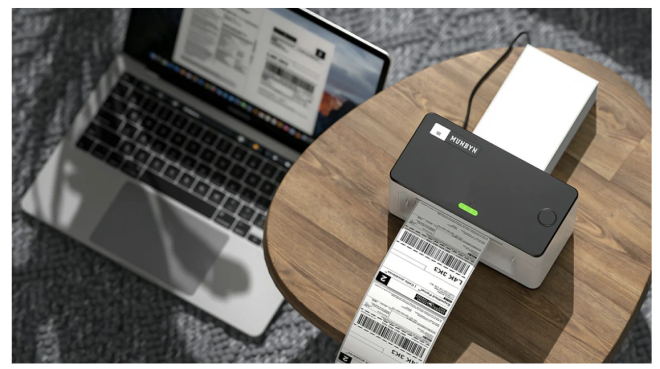- Change theme
The Everyday Utility of Label Printers and Thermal Labels: Organizing the Modern World

In a world where speed, clarity, and organization are more important than ever, labeling plays a surprisingly critical role.
09:08 23 April 2025
In a world where speed, clarity, and organization are more important than ever, labeling plays a surprisingly critical role. Whether you're shipping packages, organizing inventory, running a small business, or just trying to bring order to your home, having a reliable label printer and a good set of thermal labels can be a game changer.
Labeling may not seem exciting, but it touches nearly every part of our daily lives. From the packages on your doorstep to the files in your office and the spices in your kitchen, labels help us make sense of what’s what. And as more people embrace e-commerce, remote work, and digital side hustles, the need for efficient labeling has only grown.
What Is a Label Printer?
A label printer is a device specifically designed to print adhesive labels. Unlike traditional inkjet or laser printers, which are meant for paper documents, label printers are built to handle a variety of label materials, sizes, and formats. They’re commonly used in shipping, retail, warehousing, and administrative environments.
Some label printers use ink or toner, but many modern models rely on thermal printing—a faster, cleaner, and often more cost-effective method. These printers produce high-quality prints quickly, without smudging or the need for frequent cartridge replacements.
How Thermal Printing Works
Thermal printers use heat instead of ink. In direct thermal printing, the printer heats up special thermal paper or thermal labels, which change color when exposed to the heat. In thermal transfer printing, heat is used to transfer ink from a ribbon onto the label.
Direct thermal printing is popular for short- to medium-term labeling needs, such as shipping labels or food packaging, because it's low maintenance and reliable. Thermal transfer is better for long-lasting, durable labels—like those used in outdoor settings or industrial environments.
The big advantages? No ink, no mess, and very little maintenance. You don’t have to worry about running out of cartridges, which can reduce operating costs over time.
The Role of Thermal Labels
Thermal labels are specially treated to work with thermal printing technology. They're used in a wide range of applications because they’re durable, legible, and quick to print. Depending on the type of printer and intended use, thermal labels can be water-resistant, fade-resistant, or even weatherproof.
Here are a few common places where thermal labels show up:
- Shipping and logistics: Address and barcode labels are essential for tracking packages efficiently.
- Retail: Price tags, product descriptions, and barcode stickers make inventory easier to manage.
- Healthcare: Labels on patient wristbands, prescriptions, or test tubes need to be sharp and smudge-proof.
- Foodservice: Date labels, ingredient tags, and storage instructions help meet health regulations.
- Home organization: From kitchen jars to moving boxes, thermal labels make everything easier to find.
Why Labeling Matters More Than Ever
We live in a time when information needs to be both accessible and accurate—especially in fast-paced environments. That’s where labeling becomes more than just a detail; it becomes a system of efficiency.
For example, a small business shipping dozens of packages a day can't afford to handwrite labels. Mistakes can delay delivery or lead to lost packages. A label printer solves that problem by creating clear, consistent, scannable labels in seconds.
In hospitals, clear labeling can be the difference between a safe procedure and a dangerous error. In warehouses, it can streamline operations and reduce inventory mistakes. Even at home, a labeling system can help keep things from spiraling into chaos.
The bottom line? Good labeling saves time, prevents errors, and improves communication—whether between people or machines.
Choosing the Right Setup
If you're considering a label printing system, it's important to match the right label printer and thermal labels to your needs. Here are a few factors to think about:
- Volume: How many labels do you need to print in a day or week? A home organizer has different needs than a busy fulfillment center.
- Label type: Will your labels be exposed to moisture, heat, or sunlight? Choose thermal labels that fit the environment.
- Size and format: Some printers support a wide range of label sizes and shapes; others are more limited.
- Connectivity: USB, Wi-Fi, Bluetooth—choose what fits your workspace setup.
- Software compatibility: Make sure the printer works with your label design software or shipping platform.
Real-World Applications
To understand the value of label printing, just look around:
- A small online seller uses thermal labels to prepare outgoing orders.
- A teacher prints name tags for a classroom of students.
- A warehouse worker scans barcodes for real-time inventory tracking.
- A parent organizes bins and files with printed labels for a clutter-free home.
In all of these cases, the combination of a reliable printer and the right label material makes the job faster, easier, and more efficient.
Final Thoughts
In today’s connected, fast-moving world, clear communication and organization are essential. Labeling is a small detail that has a big impact, whether you're managing a business, a facility, or your own home.
A good label printer paired with quality thermal labels helps simplify the chaos, improve accuracy, and save time. It’s not about fancy technology—it’s about making everyday tasks run smoother and smarter.
